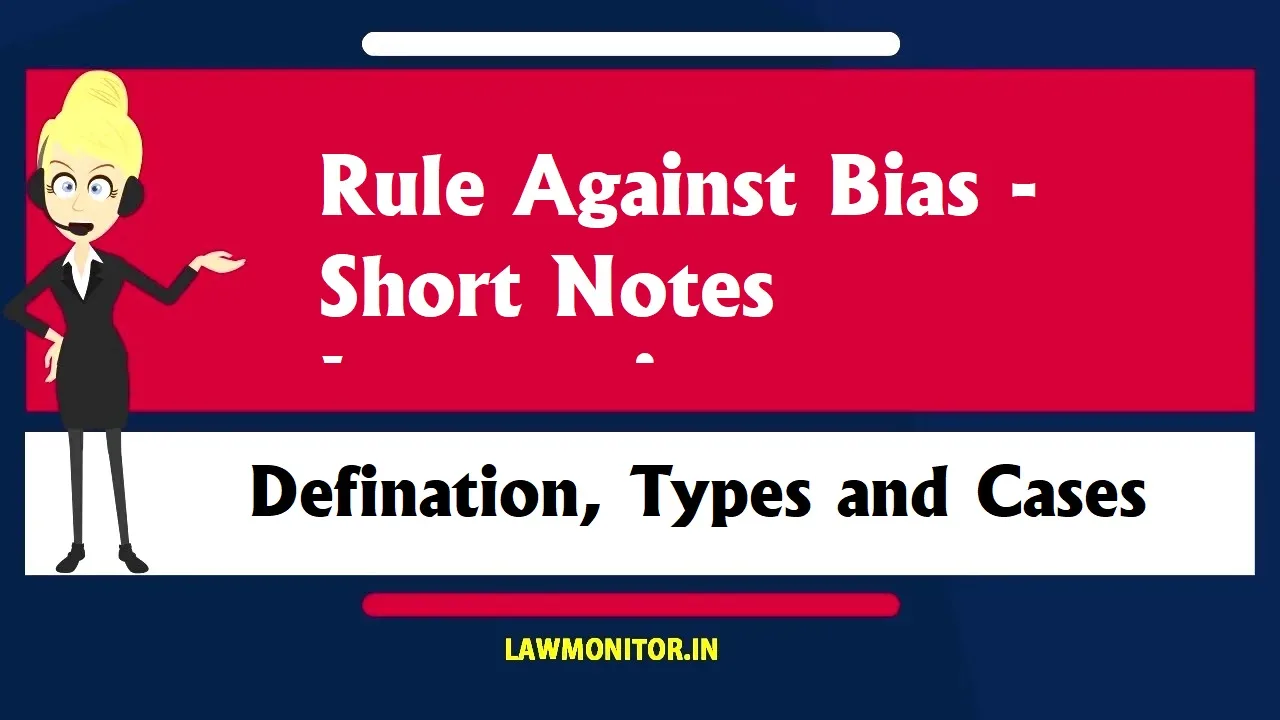The Rule Against Bias is a core principle of natural justice, ensuring that decision-makers are impartial and act without prejudice. Bias involves any preconceived opinions or predispositions that could affect one’s judgment, leading to decisions based on factors beyond the presented evidence. This rule seeks to prevent improper influences from affecting a judge’s decision, acknowledging that human nature often favors one’s own interests. The ultimate goal is to build public trust in the fairness of administrative decisions.
As highlighted by Lord Hewart CJ in R v. Sussex, justice must not only be served but also be perceived as being done. A decision compromised by bias is deemed invalid, rendering the trial “Coram non judice” (before a judge lacking proper authority)
| Read Full Administrative Law Notes | Click Here |
What is Rule Against Bias
The Rule Against Bias ensures that decision-makers and judges must remain impartial, free from personal, financial, or preconceived opinions that could influence their judgment. It is a cornerstone of natural justice, ensuring fair and unbiased proceedings.
Principle:
Nemo in propria causa judex: This principle, meaning “no one should be a judge in their own case,” is the foundation of the rule against bias. It prevents any conflict of interest that could lead to an unfair judgment.
Types of Bias:
Personal Bias:
Arises from a personal relationship between the decision-maker and one of the parties involved, potentially leading to favoritism.
- Example: In Ramanand Prasad Singh vs. UOI, a panel member related to a candidate was asked to recuse themselves to maintain impartiality.
Pecuniary Bias:
Occurs when a decision-maker stands to gain financially from the outcome, no matter how small the benefit.
- Example: In J. Mohapatra & Co. v. State of Orissa, a committee member was also an author of the books being considered, leading to invalidation of the decision due to potential financial gain.
Subject Matter Bias:
Happens when the decision-maker has a direct or indirect interest in the subject matter of the case.
- Example: In Gullapalli Nageswara Rao v. A.P.S.R.T.C., the Secretary involved in a transport hearing had a conflict of interest, leading to the decision being quashed.
Policy Notion Bias:
Refers to bias from preconceived notions or policy decisions made by the decision-maker.
- Example: In T. Govindaraja Mudaliar v. State of T.N., the Supreme Court found no bias in a Home Secretary’s hearing, despite prior involvement in forming the policy under scrutiny.
Pre-Conceived Notion Bias:
Occurs when the decision-maker holds pre-existing opinions about the case, affecting impartiality.
- Example: In Kondala Rao v. APSRTC, the court rejected claims of bias, emphasizing that prior policy decisions did not necessarily indicate bias.
Bias on Account of Obstinacy:
Arises when a decision-maker stubbornly upholds their decision despite valid reasons for reconsideration.
- Example: In A.U. Kureshi v. High Court of Gujarat, a judge’s involvement in both the disciplinary committee and the subsequent appeal was deemed improper, leading to the Supreme Court overturning the decision.
Importance of the Rule Against Bias:
This rule is critical to upholding justice and fairness in judicial and administrative processes. Violations can result in the invalidation of decisions and processes, as they would be considered unfair and unlawful.
Case Studies Highlighting the Rule Against Bias:
- Personal Bias: Mineral Development Corporation Ltd. v. State of Bihar and G.N. Nayak v. Goa University demonstrated how personal relationships or professional connections could raise reasonable suspicion of bias.
- Pecuniary Bias: The J. Mohapatra & Co. case underscored how financial interests, even indirect ones, could invalidate a decision.
- Subject Matter Bias: The Gullapalli Nageswara Rao case showed that involvement in the subject matter could create an unacceptable conflict of interest.
- Departmental Bias: The Krishna Bus Service Pvt Ltd. v. State of Haryana case illustrated how internal conflicts within departments could compromise fairness.
- Policy Notion Bias and Pre-Conceived Notion Bias: Cases like T. Govindaraja Mudaliar and Kondala Rao revealed that prior involvement in policy formation or preconceived opinions didn’t necessarily imply bias unless they unduly influenced the decision-making process.
- Bias on Account of Obstinacy: The A.U. Kureshi case highlighted how obstinacy could lead to bias, particularly when the same individual is involved in multiple aspects of a decision.
These notes encapsulate the essence and application of the Rule Against Bias across various judicial scenarios, emphasizing the need for impartiality in ensuring justice.
Conclusion: The Rule Against Bias is a fundamental principle in natural justice and fair administrative proceedings. It ensures that decision-makers maintain impartiality and are free from any personal, financial, or preconceived biases that might influence their judgment. By safeguarding against various forms of bias—including personal bias, pecuniary bias, subject matter bias, policy notion bias, pre-conceived notion bias, and bias on account of obstinacy—the rule upholds the integrity and fairness of judicial and administrative processes, ensuring that justice is both served and seen to be served.
Download PDF Notes
Wait Time remaining: 50 seconds
What is Rule Against Bias?
The Rule Against Bias ensures that decision-makers and judges must remain impartial, free from personal, financial, or preconceived opinions that could influence their judgment.
How many Types of Bias?
There are 6 types of bias: Personal Bias,Pecuniary Bias,Subject Matter Bias,Policy Notion Bias,Pre-conceived Notion Bias,Bias on Account of Obstinacy



